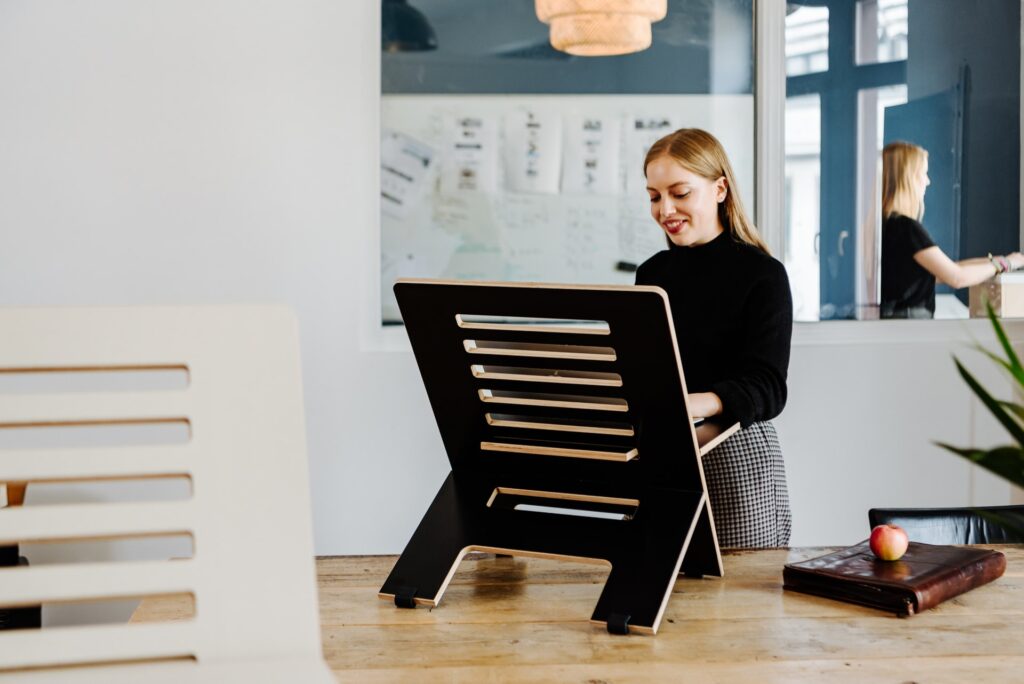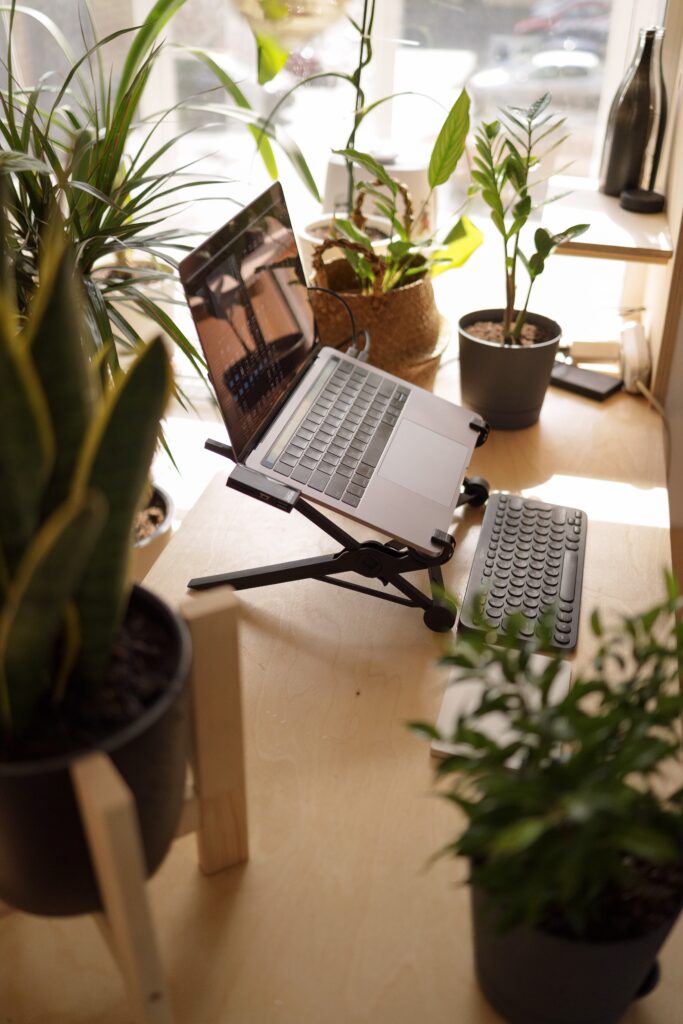
Hey you! We see you squinting at the screen, leaning in, hunching those shoulders and generally sitting in a way which is inevitably going to do harm to your back. No, we haven’t taken control of your webcam. Neither are we behind you…you looked round to check, didn’t you?
Instead, we’re simply making an educated assumption, based on the fact that nearly 24 million Brits are currently working from home, often in hastily cobbled together arrangements featuring ironing boards, book stacks and a collection of plugs which would have an electrician shocked.
With home offices less ergonomically design-focused than your standard office (your dog fronting the HR department probably isn’t going to install that new wrist supporting keyboard you’ve been coveting), those who are currently #wfh are having to adapt to their surroundings in inventive ways – from using software for asynchronous work all the way to the most creative of furniture solutions.
Your desk needs to be a devoted workspace, at the correct height and with good back support from an upright, sturdy chair. With laptops on laps, as we hunch over to read and type, we’re placing greater strain on our neck and shoulders, and risking injury. We’re in this for the long haul, so here’s 5 tips for the IDEAL home office desk setup.
INVEST IN A STANDING DESK
When it comes to working from home, standing desks are a saving grace; an antidote to the ever increasing sedentary lifestyle so many of us lead and its associated risks. With the stroll from tube station to office now eliminated because we’re working from home (for some, the only exercise of the day), getting moving has never been more pressing.
The best way you can encourage a little movement and flexibility in your home office setup is by installing a standing desk, which helps burn off calories and keeps those limbs nimble. Getting your blood flowing and increasing your metabolism can only be a good thing, and when combined with a light exercise regime, can give a big lift to your physical health.
Many experienced home office workers set an alarm to remind them every fifteen or thirty minutes to take themselves for a short walk around their home; the smallest effort can make a huge difference to your health, and we’d recommend following suit.

OR, FULLY CUSTOMISE YOUR DESK
To meet your specific work needs, consider customising your desk. An ergonomic stand-up desk, like we mentioned, is great when combined with an adjustable desk converter which can be positioned at the exact correct height for to match you at the correct sitting and typing posture.
This may provide you with better flexibility and enable free movement while working, and is increasingly believed by scientists to be massively beneficial to those at risk from an overly sedentary working day.
Should you be making the permanent shift to home working and want things to be perfectly aligned, consider an online builder to customise your home office desk to the nearest millimetre. This free online tool will help you to visualize the desk and work through the measurements in precise detail. And the best bit? A four-position memory keypad comes as standard, with more settings available (at a cost, of course), meaning that you can switch between standing and sitting desk heights easily.
A LAPTOP STAND
That said, not everyone has space for a desk. If you’re working from a laptop rather than desktop, as so many of us have been, you might be causing yourself eye, back and wrist strain by leaning into your screen excessively and manipulating your keyboard and mouse at an uncomfortable angle. As a general rule of thumb, your screen should be at least 50 centimetres from your eyes (around arm’s distance) and slightly below eye level.
Consider investing in a laptop stand to mitigate some of these concerns. These neat little structures lift your screen to a more appropriate height (though not with the accuracy of a customisable desk, mind) and go some way to preventing you hunching over or straining your eyes.
For those who find themselves frequently on the move or working remotely, it’s essential to ensure ergonomics are not compromised, even with portable devices. If purchasing a top-notch laptop isn’t feasible, consider exploring options to rent laptops for specific work trips, which can provide access to high-performance, high-resolution machines (less eye strain!) without the high upfront cost. Luckily, most laptop stands are suitable for all models of laptops. They are also foldable and lightweight, which makes carrying them around a breeze.

WIRELESS ACCESSORIES
Sit back, take a load off, your screen is now at the correct height. Adjust your bottom and spine against the chair’s back at a sturdy though flexible right angle; doesn’t that feel better? Or, if you’re standing, we salute you! That’s pure dedication to a life less sedentary right there.
Now, all you have to worry about is the two devices which enable you to complete your work each day; your keyboard and your mouse. You’ll find that your keyboard may now be at a slightly awkward position.
If you’re serious about this working from home thing, typing needs to happen from a manageable distance away from the computer, with wrists rested on your desk a couple of inches in front of your keyboard and at right angles (or slightly below) to your elbows. This will help you avoid a repetitive strain injury. It’s best here to invest in a Bluetooth keyboard, so you can position your keys in the ideal alignment to your body and hands.
It’s best here to invest in a Bluetooth mechanical keyboard, so you can position your keys in the ideal alignment with your body and hands. It’s also important to keep said keyboard well maintained as you tend to use excessive force on keys that are sticking or broken. Kinetic Labs has some keyboard care accessories and replacement parts available if you need them.
If we’re going the whole hog, then a Bluetooth mouse will certainly do no harm either. Ideally, your mouse should be half a forearm’s length from your body, with your wrists supported on the desk. Again, a wireless version of this office standard allows for greater flexibility. Just remember to invest in some batteries!
NATURAL LIGHTING
Someone is going to have to face up to it; the days are getting significantly shorter now, and a chill has entered the air. Tragic, we know, since we haven’t properly enjoyed this year’s summer. For productivity and peace of mind’s sake, equally, it’s imperative that you make the most of the natural light while it’s here, by positioning office desks in a way which makes the most of them.
It’s also a health-conscious move for your eyes; recent analysis regarding an office’s impact on health found that employees who sit within 10 feet of a window reportedly had 84% fewer eyestrain instances, headaches and blurred vision symptoms. Wow! And that’s not all, a study reported in Forbes concluded that fresh air can make the workforce 11% more productive. Harness this energy via windows in your home office and watch the creativity blossom.
That said, it’s smart to ensure that the natural light in your home office is managed properly; align your workspace or desk in a way which means the sunlight doesn’t disrupt your work by being too bright or creating shadows. Having a light source directly behind, overhead, or in front of the screen creates a glare on it, which only leads to strain. Instead, position your screen in such a way that the light source comes from the sides or below.





